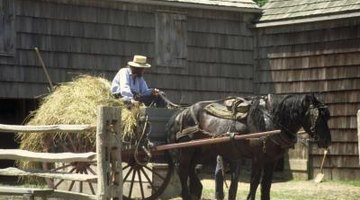How Does a Gas Freezer Work?
Freezers and refrigerators that run on propane gas, natural gas or other types of fuel use heat to power their refrigerating cycle rather than an electrically-powered compressor. These appliances have no moving parts and are virtually silent. Their operating principle was discovered in 1824 but not commercialized until the 1930s when gas refrigerator/freezers were introduced for the Amish and others who lived without electricity by choice or by necessity. As of June 2011, they are still produced.
Cold From Heat

A non-electric refrigerator/freezer uses a mixture of water, ammonia and hydrogen in a sealed pressurized system to create cold temperatures inside the refrigerator/freezer. The refrigeration system consists of a boiler, separator, condenser, evaporator and absorber. It is pressurized to the level where ammonia remains a liquid when at room temperature. The whole refrigeration cycle relies on the physics of heat transfer, pressure differentials and gravity to operate without electricity.
Cooling Cycle's Start
The cooling cycle starts at the boiler, where heat from a gas flame is applied to the mixture of water and ammonia in the boiler. The ammonia boils at a lower temperature than the water and starts to bubble. The boiler feeds directly into a percolator pump where the ammonia bubbles rise. The bubbles contain a mixture of ammonia gas, liquid water, steam and liquid ammonia. When the bubbles “perk” to the top of the pump, they burst, releasing nearly pure ammonia vapor with a trace of steam. The liquid ammonia and water flow back down to the boiler while the hot ammonia vapor rises through a separator that extracts the traces of water from the vapor.
Hot Vapor Condenses
The hot, dry ammonia vapor rises into the condenser, a device consisting of finned pipes where heat from the ammonia flows to the cooler outside air. As the ammonia vapor loses heat to the outside air, it condenses back into a liquid that flows downward by gravity to the evaporator. The evaporator contains hydrogen gas, which chemically reacts with the ammonia to vaporize it. This chemical reaction requires heat, which is taken from the interior of the refrigerator/freezer box, thus cooling the box and its contents.
Back to Start
The mixture of ammonia and hydrogen flows by gravity to the absorber chamber, where water has pooled. In the absorber, the ammonia recombines with the water, releasing the hydrogen gas to rise back up into the evaporator coil. The water/ammonia solution runs back down to the boiler and is heated again to continue the refrigeration cycle.
References
Writer Bio
Herb Kirchhoff has more than three decades of hands-on experience as an avid garden hobbyist and home handyman. Since retiring from the news business in 2008, Kirchhoff takes care of a 12-acre rural Michigan lakefront property and applies his experience to his vegetable and flower gardens and home repair and renovation projects.
Photo Credits
- Ablestock.com/AbleStock.com/Getty Images
More Articles



